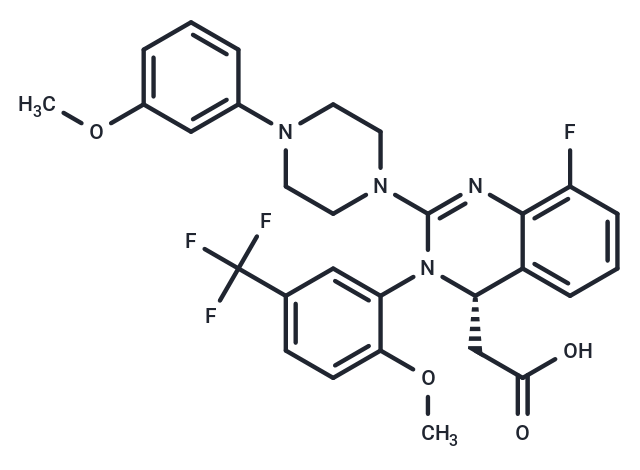Shopping Cart
- Remove All
 Your shopping cart is currently empty
Your shopping cart is currently empty

Letermovir (AIC246) (AIC246) is a novel anti-CMV compound (EC50: about 5 nM in fibroblast cells). It targets the pUL56 subunit of the viral terminase complex.

| Pack Size | Price | Availability | Quantity |
|---|---|---|---|
| 1 mg | $80 | In Stock | |
| 2 mg | $119 | In Stock | |
| 5 mg | $219 | In Stock | |
| 10 mg | $297 | In Stock | |
| 25 mg | $525 | In Stock | |
| 50 mg | $762 | In Stock | |
| 100 mg | $1,070 | In Stock | |
| 500 mg | $2,130 | In Stock | |
| 1 mL x 10 mM (in DMSO) | $268 | In Stock |
| Description | Letermovir (AIC246) (AIC246) is a novel anti-CMV compound (EC50: about 5 nM in fibroblast cells). It targets the pUL56 subunit of the viral terminase complex. |
| Targets&IC50 | HCMV:~5 nM (in fibroblast cells) |
| In vitro | The inhibitory potency of Letermovir surpasses ganciclovir (GCV) by more than 400-fold with respect to EC50s (mean, ~4.5 nM versus ~2 μM) and by more than 2,000-fold with respect to EC90 values (mean, ~6.1 nM versus ~14.5 μM). NHDF monolayers showed no microscopically apparent cytotoxic effects at Letermovir concentrations of <33 μM when observed during antiviral assays [1]. Letermovir is remarkably specific for human cytomegaloviruses since no significant activity was noted against any other herpesvirus tested. The EC50s obtained for RCMV and MCMC indicated that no (RCMV) or only a very low-level (MCMV, 4.51 μM) Letermovir sensitivity could be detected even for rodent cytomegaloviruses [2]. |
| In vivo | Letermovir treatment led to a dose-dependent reduction of the HCMV titer in transplanted cells compared to that of the placebo-treated control group using the mouse xenograft model. Statistical analysis revealed significant antiviral effects for the 10-, 30-, and 100-mg/kg/day treatment groups of Letermovir as well as for the 100-mg/kg/day VGCV control group [1]. The incidence of prophylaxis failure with letermovir, as compared with placebo, was 48% versus 64% at a daily letermovir dose of 60 mg, 32% at a dose of 120 mg, and 29% at a dose of 240 mg. Kaplan-Meier time-to-onset profiles for prophylaxis failure showed a significant difference in the comparison of letermovir at a dose of 240 mg per day with placebo [3]. |
| Cell Research | Briefly, 96-well microtiter plates were seeded with 1.5 × 10^4 cells/well and incubated overnight. Drugs were added to the wells in 3-fold serial dilutions starting from 0.33 mM (the DMSO concentration was kept constant at 0.66% throughout the whole plate). After a 7-day incubation period, alamarBlue solution was added to each well and the fluorescence signal was measured using a SpectraFluor Plus fluorescence reader. The relative fluorescence units of treated wells were expressed as percentages of untreated cell control wells and plotted against the logarithm of drug concentrations. Drug concentrations reducing cell viability by 50% (CC50s) were determined from dose-response curves. The assays were performed at least three times with duplicate samples. CC50 values were used to calculate the selectivity index (SI = CC50/EC50) for individual substances [1]. |
| Animal Research | Briefly, Gelfoam hemostyptic gelatin devices were cut aseptically into 1-cm2 pieces. These implants were soaked in NHDF cell culture growth medium (GM), and sponges were brought to 37°C in a CO2 incubator. NHDF cells were infected with cell-free HCMV strain Davis at an MOI of 0.03. After 4 h, cells were collected by trypsinization followed by centrifugation at room temperature for 10 min at 800 × g. Cells were resuspended in GM and counted using a hemocytometer. Each Gelfoam implant was seeded with a suspension of 1 × 10^6 infected cells by pipetting the cells onto the sponges. Human cells were allowed to adhere to the collagen sponges for at least 3 to 4 h at 37°C. To enhance vascularization of the implant, 250 ng recombinant human basic fibroblast growth factor was pipetted onto each implant 1 h prior to transplantation. Mice (18 to 25 g body weight) were anesthetized, and the Gelfoam sponges were implanted subcutaneously in the dorsoscapular area. After transplantation, mice were randomized and grouped in ~10 animals per treatment group. Starting 4 h after transplantation, mice were treated once daily with the indicated compounds for nine consecutive days. Drugs were applied per os by oral gavage. Total administration volume was 10 ml/kg. Mice were sacrificed after 9 days of treatment, and the Gelfoam implants were removed and digested with collagenase at 37°C. After 2 to 3 h, human cells were recovered by centrifugation and resuspended in GM. Subsequently, the isolated cell suspensions were serially diluted and mixed with uninfected NHDF indicator cells and PFU were determined by plaque assays. Virus titers determined from isolated cells are given as PFU/ml [1]. |
| Alias | MK-8828, AIC246 |
| Molecular Weight | 572.55 |
| Formula | C29H28F4N4O4 |
| Cas No. | 917389-32-3 |
| Smiles | COc1cccc(c1)N1CCN(CC1)C1=Nc2c(F)cccc2[C@H](CC(O)=O)N1c1cc(ccc1OC)C(F)(F)F |
| Relative Density. | 1.37 g/cm3 (Predicted) |
| Storage | Powder: -20°C for 3 years | In solvent: -80°C for 1 year | Shipping with blue ice. | ||||||||||||||||||||||||||||||||||||||||
| Solubility Information | Ethanol: 2 mg/mL (3.49 mM), Sonication is recommended. DMSO: 70 mg/mL (122.26 mM), Sonication is recommended. | ||||||||||||||||||||||||||||||||||||||||
Solution Preparation Table | |||||||||||||||||||||||||||||||||||||||||
Ethanol/DMSO
DMSO
| |||||||||||||||||||||||||||||||||||||||||

Copyright © 2015-2025 TargetMol Chemicals Inc. All Rights Reserved.